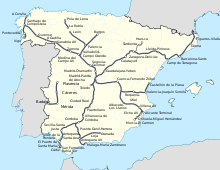Avant (train)
 | |
 | |
| Fleet size | Avant S-104 Avant S-114 Avant S-121[1] |
|---|---|
| Parent company | Renfe |
| Technical | |
| Track gauge | Standard (1435 mm), Iberian (1668 mm) (only in Galicia)[1] |
| Electrification | 25 kV AC (some sections on 3 kV DC network)[1] |
| Other | |
| Website | www |
Avant is a high-speed, medium-distance passenger transport rail service, operated in Spain by the Spanish public company Renfe.[2][3] Avant services circulate at a maximum speed of 250 km/h, compared to the 300 km/h maximum speed of the AVE service. Their routes usually cover different provinces within the same autonomous community or between neighboring ones. Regional services at conventional speed are called Renfe Media Distancia.[4][1][5][2]
Avant services are carried out by series 104, 114 and 121 trainsets, in a single class configuration without a cafeteria (except in some series 104 units).[1][5]
History[edit]
In October 1992, a new high-speed medium distance service (AV Media Distancia operating under the AVE Lanzadera brand) began between Madrid, Ciudad Real and Puertollano, using spare class 100 trains.[6][7] In November 2003 a new service began between Seville and Córdoba using new class 104 trains,[5] reducing journey times between the two cities to 40 minutes.
In 2004 the brand was renamed RENFE Avant, and all services started to use Avant S-104 trains, leaving class 100 for AVE services.[8] The construction of a 21-kilometre (13 mi) stretch of high-speed line from Madrid to Toledo allowed the inauguration of a medium distance service in November 2005. The journey time between the two cities is now less than 30 minutes.[9] The high-speed link combined with high property prices in Madrid has encouraged many Madrid commuters to settle in Ciudad Real, the first stop on the Madrid–Seville line. There has, however, been controversy over the construction of this line as the change to standard-gauge track meant that towns such as Getafe, Aranjuez and Algodor, which now have no commercial services, lost their direct services to Toledo. Furthermore, since Toledo is now connected by standard-gauge track it is impossible for other passenger or goods trains to reach it that have not come from other high-speed lines.
Further Avant services have been launched since then with the expansion of the high-speed lines to Valladolid, Barcelona, Málaga, Valencia, Granada, Murcia and Galicia.[2][10][11]
Services[edit]

As of 2024[update] Renfe offers the following Avant services:[2]
- A Coruña–Santiago de Compostela–Ourense.
- Barcelona−Girona.
- Barcelona−Girona−Figueres.
- Barcelona–Tarragona–Lleida.
- Calatayud–Zaragoza.
- Granada–Córdoba–Seville via Loja, Antequera and Puente Genil-Herrera.
- Madrid–Ciudad Real–Puertollano.
- Madrid–Segovia–Valladolid.
- Madrid–Toledo.
- Málaga–Córdoba–Seville via Antequera and Puente Genil-Herrera.
- Málaga–Granada via Antequera and Loja.
- Murcia–Alicante via Beniel, Orihuela, Callosa Cox and Elx.[12]
- Ourense–Santiago de Compostela–A Coruña.
- Toledo–Madrid–Albacete via Cuenca.
- Valencia–Requena Utiel.
Former services:
- Barcelona–Tortosa via Camp de Tarragona, Cambrils and L'Hospitalet de l'Infant.[13]
- Zaragoza–Huesca via Tardienta.[14][15]
Trains[edit]


Currently, there are the following series of high-speed trains that run the Avant service:[1]
- Avant S-104, manufactured by Alstom and CAF
- Avant S-114, manufactured by Alstom and CAF
- Avant S-121, manufactured by CAF and Alstom
Both Avant class 104 and class 114 trains are Pendolino designs, without tilting capacity:
See also[edit]
High-speed rail services in Spain[edit]
Rail infrastructure in Spain and Europe[edit]
- Rail transport in Spain
- High-speed rail in Spain
- High-speed rail in Europe
- Train categories in Europe
References[edit]
- ^ a b c d e f "Flota de trenes". www.renfe.com (in Spanish). Retrieved 31 October 2023.
- ^ a b c d "Mapas de líneas". Renfe. Retrieved 12 May 2023.
- ^ "Transportes, Movilidad y Agenda Urbana amplía la caducidad de los bonos Avant de Renfe con carácter permanente". www.lamoncloa.gob.es (in Spanish). 16 June 2023. Retrieved 13 November 2023.
- ^ "Renfe: Spain's state-owned railway company". www.spain-traveller.com. 4 April 2023. Retrieved 23 November 2023.
- ^ a b c "Our Trains". www.renfe.com. Archived from the original on 9 November 2016. Retrieved 25 July 2018.
- ^ "25 años de alta velocidad: así cambió la forma de viajar de 35,2 millones de españoles". www.elconfidencial.com El Confidencial (in Spanish). 4 August 2017. Retrieved 16 November 2023.
- ^ "Avant, 25 años uniendo personas". www.madridiario.es (in Spanish). 9 October 2017. Retrieved 31 October 2023.
- ^ "Línea Madrid – Sevilla". www.adifaltavelocidad.es (in Spanish). Retrieved 31 October 2023.
- ^ "Avant Toledo-Madrid: 23,5 millones de viajeros en 17 años". www.latribunadetoledo.es (in Spanish). 14 November 2022. Retrieved 31 October 2023.
- ^ "Renfe increases frequency of Avant Malaga-Granada trains". www.surinenglish.com. 29 July 2022. Retrieved 23 November 2023.
- ^ "Renfe launches Granada - Seville high-speed service". www.railjournal.com. 18 February 2020. Retrieved 23 November 2023.
- ^ "Renfe incorpora los trenes Avant en la línea Alicante-Murcia: 50 minutos de viaje y cuatro paradas". alicanteplaza.es (in Spanish). 14 December 2022. Retrieved 24 November 2023.
- ^ "Renfe NON-FINANCIAL INFORMATION STATEMENT 2020" (PDF). RENFE-Operadora. Retrieved 24 November 2023.
- ^ "Elboj pide reunirse con el Gobierno de Aragón tras conocer que Renfe quiere suprimir los Avant entre Huesca y Zaragoza". www.europapress.es (in Spanish). 22 September 2009. Retrieved 24 November 2023.
- ^ "Primeras críticas a la supresión de los Avant Huesca-Zaragoza". cadenaser.com (in Spanish). 14 March 2018. Retrieved 24 November 2023.

